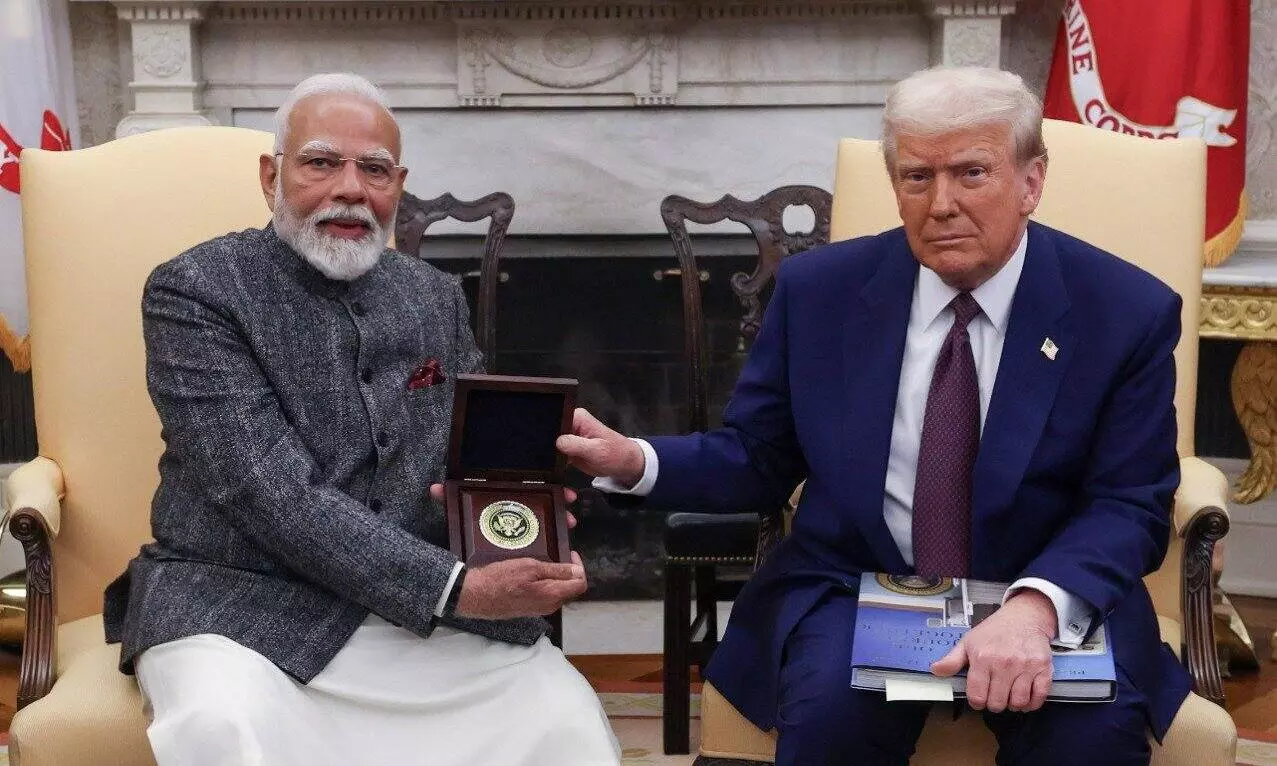
- Home
- India
- World
- Premium
- THE FEDERAL SPECIAL
- Analysis
- States
- Perspective
- Videos
- Sports
- Education
- Entertainment
- Elections
- Features
- Health
- Business
- Series
- In memoriam: Sheikh Mujibur Rahman
- Bishnoi's Men
- NEET TANGLE
- Economy Series
- Earth Day
- Kashmir’s Frozen Turbulence
- India@75
- The legend of Ramjanmabhoomi
- Liberalisation@30
- How to tame a dragon
- Celebrating biodiversity
- Farm Matters
- 50 days of solitude
- Bringing Migrants Home
- Budget 2020
- Jharkhand Votes
- The Federal Investigates
- The Federal Impact
- Vanishing Sand
- Gandhi @ 150
- Andhra Today
- Field report
- Operation Gulmarg
- Pandemic @1 Mn in India
- The Federal Year-End
- The Zero Year
- Science
- Brand studio
- Newsletter
- Elections 2024
- Events
- Home
- IndiaIndia
- World
- Analysis
- StatesStates
- PerspectivePerspective
- VideosVideos
- Sports
- Education
- Entertainment
- ElectionsElections
- Features
- Health
- BusinessBusiness
- Premium
- Loading...
Premium - Events

India can levy export duty on generic drugs to hurt US healthcare while encouraging exporters to reduce costs, find new markets; indigenise defence tech, production to send message to Trump
The 25 per cent duty on imports from India that US President Donald Trump has announced on his social media platform Truth Social might or might not stick. If India cannot negotiate it down, we can cut our losses in the US, explore new markets, and reduce costs to gain competitiveness even in the US. But India cannot knuckle down to Trump’s pressure to stop buying Russian arms or oil. If the US goes ahead with penal duties on Indian goods for India exercising its sovereign right to defend itself the way it suits India best, India should retaliate.
India must fight back
India should levy an export duty on the generic drugs India exports to the US. Nobody would find it easy to increase their generics capacity in a hurry to substitute India’s pharma exports to the US, not Israel, not Ireland. American healthcare costs would soar in the short term, and Trump and his supporters will feel the pain by the mid-term elections in 2026. That prospect should have the same effect on the bubble of grandeur in which ‘Emperor Trump’ thinks he floats, as a pin would have on an inflated balloon.
Also read: Trump’s strike on India is not surprising, what caused it is
If 25 per cent is the tariff the US ends up levying on most Indian exports to that country, we should understand that what will hurt India is not that our exports would become 25 per cent more expensive than before, but how much this 25 per cent rate exceeds the rate on India’s competitors in each segment. Indian exporters are still at an advantage, compared to the 35 per cent duty on Bangladesh’s exports to the US, and 30 per cent on Sri Lanka’s goods, 29 per cent on Pakistani goods and 36 per cent on Thai goods. The duty on Indian goods would be 6 per cent higher than on goods from Indonesia, and 5 per cent higher than the tariff on Vietnam.
How to cushion the impact?
So, if India’s tariff handicap is much smaller than what the 25 per cent duty suggests, it can safely offset 3-4 per cent just by improving logistics, and every exporter adopting the end-to-end logistics management and tracking systems now available from vendors like TVS Supply Chain Solutions Ltd.
India can stop trying to leverage just low wages and invest in increasing productivity by investing in the machinery each worker works with and by investing in worker training, which, besides improving productivity, improves earnings for the workers, and builds loyalty both ways between the employer and employee.
The tariff shock should persuade Indian exporters to forget business as usual and invest in their production process, better sourcing, and finding and nurturing new markets.
Watch: US President Trump slaps 25 pc tariff plus penalty on India: What next?
BRICS must go ahead with dollar’s replacement
All the original BRICS — Brazil, Russia, India, China, and South Africa — and new member Iran find themselves in Trump’s crosshairs. Trump has threatened BRICS with special penal duties if it persists with attempts to create an alternative to the dollar. Instead of running scared, BRICS should go ahead with its plans to erode the dominance of the dollar in global finance, working with the European Union and Canada, and if possible, Japan.
The ideal alternative to the dollar would be a stablecoin, with a value dynamically linked to a weighted basket of major currencies, including the dollar. The International Monetary Fund’s unit of account, SDR, is valued against a basket of five currencies: the dollar, the euro, the Japanese yen, the Chinese yuan, and the British pound. BRICS should persuade the European Union, Japan, Switzerland, Canada, and Britain to join them, and float a joint venture that issues a new stablecoin. These sponsors should pool in capital to invest in the currencies and government bonds of the countries that issue the currencies in the SDR basket, fully complying with the norms set out in the US Genius Act for stablecoins. The Act requires issuers of stablecoins to hold assets equivalent to the value of the stablecoins issued. This SDR-equivalent stablecoin — call it bancor, to use the name Keynes had proposed for a novel solution to trade imbalances at the Bretton Woods conference that founded the IMF — can be the one in which to quote oil prices and settle trade in transactions to which the US is not a party.
Also read: 5 reasons why Trump has imposed 25 pc tariff on India
BRICS Reinsurance, and BRICS Clear should take off, and work alongside the existing major reinsurance companies and clearing and holding agencies like Euroclear.
Defending strategic autonomy
India has to indigenise its defence technology and production. Even as efforts in this direction are redoubled, India should place an order for additional batteries of Russia’s S400 missile defence system, which was found to be effective in halting the incoming missiles and drones from Pakistan during Operation Sindoor. This should send a clear message to President Trump about where he gets off when he tries to dictate strategic terms to India.
India should announce a major expansion of its Navic satellites that replicate the geolocation service provided by America’s GPS service. Europe has its Galileo satellites, Russia, its Glonass, and China, BeiDou, for the same purpose. Iran discovered that its GPS positioning functions were disrupted during its brief war with Israel and the US, and has declared that GPS would no longer be used for official purposes. India must mandate all mobile phones sold in India to make use of Glonass and Navic satellites, in addition to GPS, paving the way for eventual ditching of GPS, when the Navic network is sufficiently large and articulated.
Salvage rules-based trade
The US has wrecked the global trading system, trampling on the Most-Favoured-Nation concept of uniform treatment of all trade interlocutors. Trump refused to nominate people to the appellate body of the World Trade Organisation’s Dispute Settlement Mechanism in his first term itself, effectively making the body dysfunctional. Now he has abandoned any pretence of respect for rules-based trade. In effect, the US has seceded from the WTO. Other members should form another WTO minus the US, instead of letting Trump wreck the entire edifice of rules-based trade. BRICS should take the lead in this effort.
Also read: Trump tariffs: FICCI expresses concern over 25 pc duty and sanctions
Now that India has abandoned its needlessly protectionist deviation in several FTAs, it should make bold and join the Comprehensive and Progressive Agreement for Trans Pacific Partnership (CPTPP), which excludes the US.
The US accounts for a quarter of world GDP, but its share of global imports is only about half as much. It is vital to keep 88 per cent of world trade open and rules-based. BRICS should lead in the effort, even as Europe staggers, and is stupefied and insecure about defence in the absence of America.
Those who had hoped that Prime Minister Modi’s friendship with ‘Dolan Trump’ would help India stave off severe tariffs should wake up to reality. The notion that the relations between nations can be shaped by personal sentiment at the highest levels now flies alongside flying carpets, in the direction of the highest tower of the castle in the sky. Do we see something fall off from this flight of fancy, and float to the ground, something warm and fuzzy, like a joke called ‘Vishwaguru’?
(The Federal seeks to present views and opinions from all sides of the spectrum. The information, ideas or opinions in the articles are of the author and do not necessarily reflect the views of The Federal)


